#eoazhdarcho
Explore tagged Tumblr posts
Text
Eoazhdarcho liaoxiensis
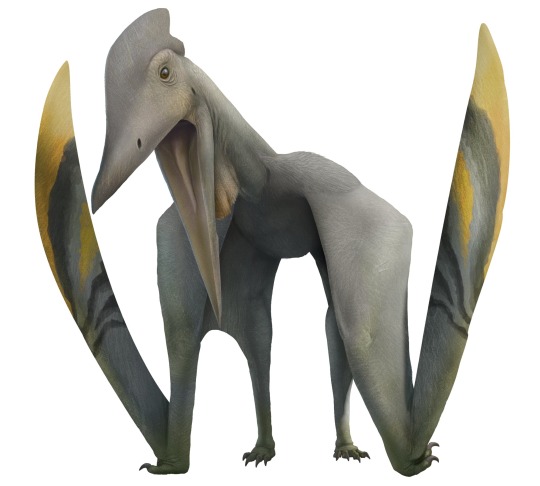
By Vitor Silva; retrieved from http://www.pteros.com/, a website dedicated to education about Pterosaurs.
A reminder that we will not be able to do every pterosaur until we reach $240 in donations on our patreon, so please donate even a dollar if you can.
First Described: 2005
Described By: Lu & Ji
Classification: Avemetatarsalia, Ornithodira, Pterosauromorpha, Pterosauria, Macronychoptera, Novialoidea, Breviquartossa, Pterodactylomorpha, Monofenestrata, Pterodactyliformes, Caelidracones, Pterodactyloidea, Eupterodactyloidea, Ornithocheiroidea, Azhdarchoidea, Chaoyangopteridae
Eoazhdarcho was so-named because it was thought to be the first Azhdarchid when it was exhumed from the Jiufotang Formation in 2005. This assignment was based on features such as long limbs, moderately elongate neck vertebrae, and a long toothless snout. This assignment didn’t last long, and in 2008 it was reassigned to Chaoyangopteridae - a group of pterosaurs with the same features also found in early Cretaceous China. Eoazhdarcho had a wingspan of about 1.6 meters (5.2 feet), and was probably omnivorous.
Source:
https://en.wikipedia.org/wiki/Eoazhdarcho
#eoazhdarcho#eoazhdarcho liaoxiensis#choyangopterid#pterosaur#pterosaur ptuesday#palaeoblr#azhdarchoid#pterodactyloid#paleontology#prehistoric life#prehistory#biology#science#nature#factfile
49 notes
·
View notes
Text
Chiappeavis magnapremaxillo
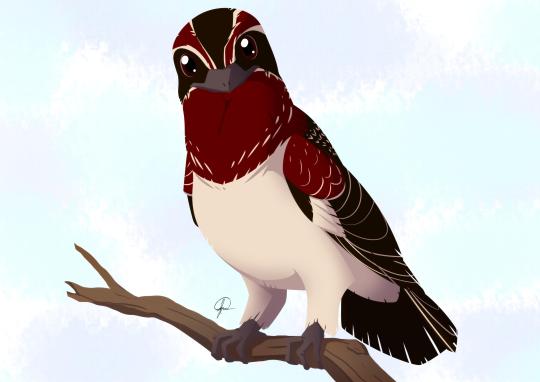
By José Carlos Cortés
Etymology: Chiappe’s Bird
First Described By: O’Connor et al, 2016
Classification: Dinosauromorpha, Dinosauriformes, Dracohors, Dinosauria, Saurischia, Eusaurischia, Theropoda, Neotheropoda, Averostra, Tetanurae, Orionides, Avetheropoda, Coelurosauria, Tyrannoraptora, Maniraptoromorpha, Maniraptoriformes, Maniraptora, Pennaraptora, Paraves, Eumaniraptora, Averaptora, Avialae, Euavialae, Avebrevicauda, Pygostaylia, Ornithothoraces, Enantiornithes, Cathayornithiformes
Status: Extinct
Time and Place: 120 million years ago, in the Aptian age of the Early Cretaceous

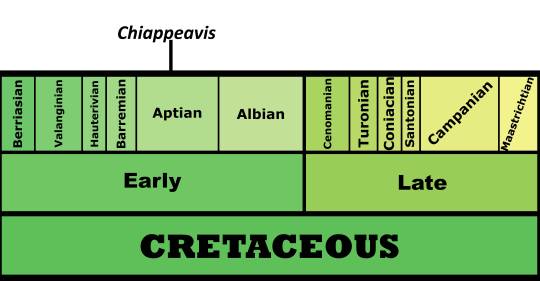
Chiappeavis is known from the Jiufotang Formation of China, specifically in the Shangheshou Beds

Physical Description: Chiappeavis was an Opposite Bird, ie the group of bird-like dinosaurs that were extremely diverse and widespread during the Cretaceous period. Chiappeavis is known from a nearly complete skeleton, including some feather impressions. It was a fairly large bird, probably around 20 or so centimeters (though this is a very rough estimate). It had a small snout, with small pointed teeth inside of it, and a fairly large head. Its body was long, and it had large wings - good for more powerful flying as opposed to tighter maneuvering in between trees. Interestingly enough, Chiappeavis had a giant tail fan, which was not actually universal among Opposite BIrds as it is in modern birds. It also had fairly thick, strong feet.
Diet: It is probable that Chiappeavis fed mainly on arthropods and other hard invertebrates.
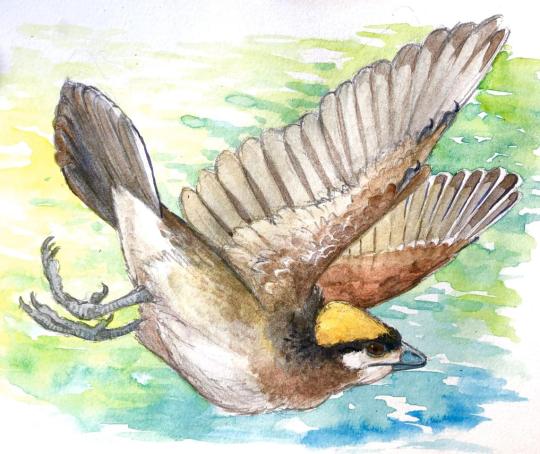
By Ripley Cook
Behavior: It is uncertain what the behavior of Chiappeavis was, given that we do not have extensive skeletons of this dinosaur. Still, it probably wouldn’t have flitted about the trees as much as birds with wings better built for maneuvering. The tail fan of Chiappeavis probably would have been extremely useful in sexual display, as well as other forms of communication - especially since it does not appear to have been very good at generating lift during flight (hence it not being widespread in other Opposite Birds). As such, it is more likely than not that Chiappeavis would have been fairly social, living in groups of multiple birds which communicated and recognized each other with feather displays. This, therefore, leads us to yet another likely hypothesis: that it took care of its young, at least to some extent. Beyond that, the behavior of Chiappeavis is a bit of a question - though it may have been able to dig out insects and other grubs with its strong feet, and then bit into the tough exteriors of these animals with its many needle-like teeth.
Ecosystem: The Jiufotang Formation was one of the Jehol Biota ecosystems, aka a group of extremely diverse and lush environments that preserved birdie dinosaurs of the Early Cretaceous with great detail. In that, Chiappeavis is one of many dinosaurs found in this location with extensive feather preservation. TheJiufotang Environment was a dense forest, surrounding an extensive number of lakes, and near volcanically active mountains. Still, it isn’t quite as well known as the earlier Yixian formation, and in fact doesn’t seem to have as many plants preserved to inform the exact environment and temperature. Still, it’s reasonable to suppose it may have also been a temperate ecosystem, like the earlier Yixian Formation, potentially even with snow.

By Jack Wood
In this environment, there were an extremely wide variety of animals. There was a decent diversity of fish, quite a few kinds of mammals, and the weird, unclassifiable Choristoderes were represented by Philydrosaurus, Ikechosaurus, and Liaoxisaurus. This ecosystem was lousy with pterosaurs, featuring a variety of Chaoynagopterids - like Chaoyangopterus itself, Eoazhdarcho, Jidapterus, and Shenzhoupterus; Pteranodonts like Guidraco, Ikrandraco, Liaoningopterus, Nurhachius, Liaoxipterus, and Linlongopterus; Tapejarids like “Huaxiapterus”, (probably) Nemicolopterus, and Sinopterus; and the weirdly late-surviving Anurognathid Vesperopterylus.
As for dinosaurs, there were many, and most were bird like! There was of course the Ankylosaur Chuanqilong, and the early Ceratopsian Psittacosaurus; there was also an unnamed titanosaur. There was a Tyrannosauroid, SInotyrannus, the Chickenparrot Similicaudipteryx, the raptor Microraptor, and tons of early Avialans like Confuciusornis, Dalianraptor, Jeholornis, Omnivoropteryx, Sapeornis, Shenshiornis, and Zhongjianornis. There were also “true” birds (ie, the line of dinosaurs that would evolve into those we see today) such as Bellulornis, Piscivoravis, Archaeorhynchus, Chaoyangia, Jianchangornis, Parahongshanornis, Schizooura, Songlingornis, Yanornis, and Yixianornis. However, the most diverse group of dinosaurs were the Opposite Birds, of which Chiappeavis was only one of many. There was Alethoalaornis, Boluochia, Bohaiornis, Cathayornis, Cuspirostrisornis, Dapingfangornis, Eocathayornis, Piscivorenantiornis, Pengornis, Gracilornis, Huoshanornis, Largirostrornis, Longchengornis, Longipteryx, Rapaxavis, Shangyang, Sinornis, and Xiangornis - just to name a few! As such the Jiufotange remains as a rich ecosystem in which to study the evolution of this fantastic group of Cretaceous dinosaurs.

By Scott Reid
Other: Chiappeavis is probably not its own thing - it is one of a number of Opposite Birds described without substantial evidence that it was a distinct genus and, indeed, many researchers consider them to be members of other genera. In this case, Chiappeavis is probably the same as Pengornis. Still, until it is officially lumped in, it must be treated as its own genus. It had a lot of similarities to Pengornis, regardless, indicating the two may belong to a larger clade of Opposite Birds. In short, Opposite Bird Phylogeny is kind of a mess, and needs a lot more intensive work than has currently been done.
~ By Meig Dickson
Sources Under the Cut
Czerkas, S. A., D. Zhang, J. Li and Y. Li. 2002. Flying dromaeosaurs. In S. J. Czerkas (ed.), Feathered Dinosaurs and the Origin of Flight. The Dinosaur Museum Journal 1. The Dinosaur Museum, Blanding, UT 96-126
Czerkas, S. A., and Q. Ji. 2002. A preliminary report on an omnivorous volant bird from northeast China. In S. J. Czerkas (ed.), Feathered Dinosaurs and the Origin of Flight. The Dinosaur Museum Journal 1. The Dinosaur Museum, Blanding, UT 127-135
Dong, Z.-M., Y.-W. Sun, and S.-Y. Wu. 2003. On a new pterosaur from the Lower Cretaceous of Chaoyang Basin, Western Liaoning, China. Global Geology 22:1-7
Dong, Z., and J. Lü. 2005. A new ctenochasmatid pterosaur from the Early Cretaceous of Liaoning Province. Acta Geologica Sinica 79(2):164-167
Dong, L., Y. Wang, and S. E. Evans. 2017. A new lizard (Reptilia: Squamata) from the Lower Cretaceous Yixian Formation of China, with a taxonomic revision of Yabeinosaurus. Cretaceous Research
Evans, S. E., and Y. Wang. 2011. A gravid lizard from the Cretaceous of China and the early history of squamate viviparity. Naturwissenschaften 98:739-743
Evans, S. E., and Y. Wang. 2012. New material of the Early Cretaceous lizard Yabeinosaurus from China. Cretaceous Research 34:48-60
Gao, K.-Q., and R. C. Fox. 2005. A new choristodere (Reptilia: Diapsida) from the Lower Cretaceous of western Liaoning Province, CHina, and phylogenetic relationships of Monjurosuchidae. Zoological Journal of the Linnean Society of London 145:427-444
Gao, K.-Q., D. T. Ksepka, L. Hou, Y. Duan, and D. Hu. 2007. Cranial morphology of an Early Cretaceous monjurosuchid (Reptilia: Diapsida) from Liaoning Province of China and evolution of the choristoderan palate. Historical Biology 19(3):215-224
Han, G., and J. Meng. 2016. A new spalacolestine mammal from the Early Cretaceous Jehol Biota and implications for the morphology, phylogeny, and palaeobiology of Laurasian ‘symmetrodontans’. Zoological Journal of the Linnean Society 178:343-380
He, H.Y.; Wang, X.L.; Zhou, Z.H.; Wang, F.; Boven, A.; Shi, G.H.; Zhu, R.X. (2004). "Timing of the Jiufotang Formation (Jehol Group) in Liaoning, northeastern China, and its implications". Geophysical Research Letters. 31 (13): 1709.
Hou, L., and J. Zhang. 1993. [A new fossil bird from Lower Cretaceous of Liaoning]. Vertebrata PalAsiatica 31(3):217-224
Hou, L. H. 1997. Mesozoic Birds of China.
Hu, D., L. Li, L. Hou and X. Xing. 2010. A new sapeornithid bird from China and its implication for early avian evolution. Acta Geologica Sinica 84(3):472-482
Hu, L. Li, L. Hou and D., X. Xu. 2011. A new enantiornithine bird from the Lower Cretaceous of western Liaoning, China. Journal of Vertebrate Paleontology 31(1):154-161.
Hu, D.-Y., X. Xu, L. Hou and C. Sullivan. 2012. A new enantiornithine bird from the Lower Cretaceous of Western Liaoning, China, and its implications for early avian evolution. Journal of Vertebrate Paleontology 32(3):639-645
Hu, Zhou and O'Connor, 2014. A subadult specimen of Pengornis and character evolution in Enantiornithes. Vertebrata PalAsiatica. 52(1), 77-97.
Hu, D., Y. Liu, J. Li, X. Xu, and L. Hou. 2015. Yuanjiawaornis viriosus, gen. et sp. nov., a large enantiornithine bird from the Lower Cretaceous of western Liaoning, China. Cretaceous Research 55:210-219
Hu, O'Connor and Zhou, 2015. A new species of Pengornithidae (Aves: Enantiornithes) from the Lower Cretaceous of China suggests a specialized scansorial habitat previously unknown in early birds. PLoS ONE. 10(6), e0126791.
Ji, Q., S.-a. Ji, and L.-j. Zhang. 2009. First large tyrannosauroid theropod from the Early Cretaceous Jehol Biota in northeastern China. Geological Bulletin of China 28(10):1369-1374
Li, J.-J., J.-C. Lü, and B.-K. Zhang. 2003. A new Lower Cretaceous sinopteroid pterosaur from western Liaoning, China. Acta Palaeontologica Sinica 42(3):442-447
Li, L., Y. Duan, D. Hu, L. Wang, S. Cheng and L. Hou. 2006. New Eoenantiornithid Bird from the Early Cretaceous Jiufotang Formation of Western Liaoning, China. Acta Geologica Sinica (English Edition) 80(1):38-41
Li, Q., J. A. Clarke, K.-Q. Gao, C.-F. Zhou, Q. Meng, D. Li, L. D'Alba and M. D. Shawkey. 2014. Melanosome evolution indicates a key physiological shift within feathered dinosaurs. Nature 507:350-353.
Li, Z., Z. Zhou, M. Wang and J. A. Clarke. 2014. A new specimen of large-bodied basal enantiornithine Bohaiornis from the Early Cretaceous of China and the inference of feeding ecology in Mesozoic birds. Journal of Paleontology 88(1):99-108
Lu, J.-C., Q.-J. Meng, B.-P. Wang, DLiu, C.-Z. Shen and Y.-G. Zhang. 2017. Short note on a new anurognathid pterosaur with evidence of perching behaviour from Jianchang of Liaoning Province, China. In D. W. E. Hone, M. P. Witton, D. M. Martill (eds.), Geological Society of London Special Publications 455:95-104.
Mortimer, M. 2016. Chiappeavis is just another Pengornis. Theropod Database Blog.
O'Connor and Chiappe, 2011. A revision of enantiornithine (Aves: Ornithothoraces) skull morphology. Journal of Systematic Palaeontology. 9(1), 135-157.
O'Connor, J. K., Y. -G. Zhang, L. M. Chiappe, Q. Meng, Q. Li and D. Liu. 2013. A new enantiornithine from the Yixian Formation with the first recognized avian enamel specialization. Journal of Vertebrate Paleontology 33(1):1-12.
O'Connor, Zheng, Sullivan, Chuong, Wang, Li, Wang, Zhang and Zhou, 2015. Evolution and functional significance of derived sternal ossification patterns in ornithothoracine birds. Journal of Evolutionary Biology. 28(8), 1550-1567.
O’Connor, J. K., X. Wang, X. Zheng, H. Hu, X. Zhang, Z. Hou. 2016. An Enantiornithine with a Fan-Shaped Tail, and the Evolution of the Rectricial Complex in Early Birds. Current Biology 26: 114 - 119.
O’Connor, J. K., X.-T. Zheng, H. Hu. X. Wang, Z.-H. Zhou, 2017. The morphology of Chiappeavis magnapremaxillo (Pengornithida: enantiornithes) and a comparison of aerodynamic function in Early Cretaceous avian tail fans. Vertebrata Palasiatica 55: 41 - 58.
Wang, X., T. Rodrigues, S. Jiang, X. Cheng, and A. W. A. Kellner. 2014. An Early Cretaceous pterosaur with an unusual mandibular crest from China and a potential novel feeding strategy. Scientific Reports 4(6329).
Wang, M., Z.-H. Zhou, and S. Zhou. 2016. A new basal ornithuromorph bird (Aves: Ornithothoraces) from the Early Cretaceous of China with implication for morphology of early Ornithuromorpha. 176(1):207-223.
Zhou, S., Z. Zhou, J. K. O’Connor. 2013. A new piscivorous ornithuromorph from the Jehol Biota. Historical Biology 26 (5): 608 - 618.
Zhou, Z.-h., F. Jin, and J.-y. Zhang. 1992. [Preliminary report on a Mesozoic bird from Liaoning, China]. Kexue Tongbao 1992(5):435-437
Zhou, Z. 1995. Discovery of a new enantiornithine bird from the Early Cretaceous of Liaoning, China. Vertebrata PalAsiatica 33(2):99-113
Zhou, X., and F. Zhang. 2001. Two new ornithurine birds from the Early Cretaceous of western Liaoning, China. Chinese Science Bulletin 46(15):1258-1264
Zhou, Z. 2002. A new and primitive enantiornithine bird from the Early Cretaceous of China. Journal of Vertebrate Paleontology 22(1):49-57
Zhou, Z., and F. Zhang. 2002. A long-tailed, seed-eating bird from the Early Cretaceous of China. Nature 418:405-409
Zhou, Z., and F. Zhang. 2002. Largest bird from the Early Cretaceous and its implications for the earliest avian ecological diversification. Naturwissenschaften 89(1):34-38
Zhou, X., and F. Zhang. 2003. Anatomy of the primitive bird Sapeornis chaoyangensis from the Early Cretaceous of Liaoning, China. Canadian Journal of Earth Sciences 40:731-747
Zhou, Z., J. Clarke, F. Zhang and O. Wings. 2004. Gastroliths in Yanornis: an indication of the earliest radical diet-switching and gizzard plasticity in the lineage leading to living birds?. Naturwissenschaften 91(12):571-574
Zhou, Clarke and Zhang, 2008. Insight into diversity, body size and morphological evolution from the largest Early Cretaceous enantiornithine bird. Journal of Anatomy. 212, 565-577.
Zhou, Z.-H., F. -C. Zhang, and Z. Li. 2009. A new basal ornithurine bird (Jianchangornis microdonta gen. et sp. nov.) from the Lower Cretaceous of China. Vertebrata PalAsiatica 10:299-310
Zhou, Z., F. Zhang, and Z. Li. 2010. A new Lower Cretaceous bird from China and tooth reduction in early avian evolution. Proceedings of the Royal Society B 277:219-227
#Chiappeavis magnapremaxillo#Chiappeavis#Opposite Bird#Bird#Dinosaur#Enantiornithine#Birblr#Palaeoblr#Factfile#Dinosaurs#Birds#Cretaceous#Eurasia#Insectivore#Mesozoic Monday#paleontology#prehistory#prehistoric life#biology#a dinosaur a day#a-dinosaur-a-day#dinosaur of the day#dinosaur-of-the-day#science#nature
174 notes
·
View notes
Text
Piscivoravis lii

By Ripley Cook
Etymology: Fish Eating Bird
First Described By: 2013
Classification: Dinosauromorpha, Dinosauriformes, Dracohors, Dinosauria, Saurischia, Eusaurischia, Theropoda, Neotheropoda, Averostra, Tetanurae, Orionides, Avetheropoda, Coelurosauria, Tyrannoraptora, Maniraptoriformes, Maniraptora, Pennaraptora, Paraves, Eumaniraptora, Averaptora, Avialae, Euavialae, Avebrevicauda, Pygostylia, Ornithothoraces, Euornithes, Ornithuromorpha, Songlingornithidae
Status: Extinct
Time and Place: 120 million years ago, in the Aptian age of the Early Cretaceous


Piscivoravis is known from the Shangheshou Beds of the Jiufotang Formation in Liaoning, China

Physical Description: Piscivoravis was a fairly large proto-bird, growing between 30 and 35 centimeters long. It had a strong wishbone, which would have allowed for extensive chest muscles, giving it better flight ability than most of its relatives at the time. It had large claws and digits on its feet and hands which would have been very noticeable in the wings - it’s possible it may have used those claws to cling to branches and tree trunks. Piscivoravis was preserved with feathers, which show that it had an alula. Alulas are a group of three to six small, stiff feathers growing off of the first digit in modern birds - not preserved often in Mesozoic birds, scientists have limited themselves to looking for the specialized structure in the first finger that would indicate their presence. However, Piscivoravis doesn’t have that structure - indicating the alula feathers evolved before the structure did. It also had a full fan of tail feathers - a distinctive trait of the birdie dinosaurs that would become birds proper. The feathers were broad and rounded to form a single aerodynamic surface, which would have helped it to fly.
Diet: Piscivoravis was found with fish preserved in its digestive tract, making it one of the few confirmed piscivorous Mesozoic birds.
Behavior: Piscivoravis would spend a lot of its time around the lakes of its environment, grabbing fish out of the water - a unique niche for it that would have helped it to avoid competition with other animals in its very diverse environment. It would have swallowed the food and separated it into digestible parts and non-digestible parts, and formed the latter into a pellet - much like modern hawks and owls do. This was preserved in its stomach, and it would then vomit up the pellet to save energy trying (and failing) to digest it.

By Scott Reid
As a strong flier, it’s possible that Piscivoravis would source over the lakes like some shorebirds today, looking for traces of fish and other aquatic sources of food under the surface. We don’t know how well it could see, however, to test if it would be able to spot such prey. It’s possible - since this was a system of lakes surrounded by forest - that Piscivoravis may have peered down at the lakes from trees (held onto with strong claws), then used their strong flight to fly down quickly towards the sources of food.
As a dinosaur, Piscivoravis most likely took care of its young, though it’s difficult to know either way without more fossils. It is uncertain whether or not it would have lived in groups - either possibility, solitary or social life, seems possible.
Ecosystem: Piscivoravis lived in the Jiufotang Formation, the later of the Jehol Biota formations that showcase the initial evolution of a lot of modern groups - especially birds, placental mammals, and flowers. It was a system of lakes, surrounded by a temperate forest. Active volcanoes nearby would explode on occasion, leading to rapid covering and then preservation of the life in the forest. The earlier Yixian Formation is somewhat better known and more diverse than the Jiufotang, but there was still a lot of fascinating creatures in the Jiufotang. Piscivoravis is known from the Shangheshou Bed, aka the second and third members of the formation, where a lot of the more famous animals of the environment are found. The environment was probably still heavily forested, mostly populated with coniferous trees and ferns, but with some burgeoning flowers as well. There was a variety of frogs and fish for Piscivoravis to feed on, though most of the named ones come from other parts of the formation.
Mammals were present in the formation - notably Lactodens and Liaconodon. The oddball, crocodile-esque Choristoderes were represented by Philydrosaurus and Ikechosaurus. Turtles include Perochelys and Liaochelys. There was the famed Jiufotang Lizard Yabeinosaurus as well. There were a lot of pterosaurs, including Sinopterus, Linlongopterus, Liaoxipterus, Chaoyangopterus, Longchengpterus, Eoazhdarcho, Huaxiapterus, Hongshanopterus, Jidapterus, and Shenzhoupterus. And this was just the non-dinosaurs.

By José Carlos Cortés
Dinosaurs included - well, there were a lot of them. The only Ornithischian known from this member was Psittacosaurus. There were a few non-Avialan theropods, too, such as Sinotyrannus, Microraptor and Similcaudipteryx. Still, the fast majority of dinosaurs present were birdie dinosaurs, which I’m just going to list now: Longipteryx, Confuciusornis, Omnivoropteryx, Sapeornis, Sinornis, Yixianornis, Bohaiornis, Parabohaiornis, Longusunguis, Juehuaornis, Parapengornis, Fortunguavis, Cathayornis, Largirostrornis, Yanornis, Gracilornis, Eocathayornis, Jeholornis, Schizooura, Zhongjianornis, Jianchangornis, Archaeorhynchus, Songlingornis, Chaoyangia, Longchengornis, Boluochia, Houornis, Xiangornis, Huoshanornis, Pengornis, Dapingfangornis, Piscivorenantiornis, Parahongshanornis, Alethoalaornis, Yuanjiawaornis, and Bellulornis. Feel free to dig through the ADAD blog to find out about all of these. Piscivoravis probably would have feared Sinotyrannus the most out of all these members of its environment, in terms of what would eat it.
Other: Piscivoravis was a Songlingornithid, a group of early very-near-birds found in the Aptian age of China. Many other kinds coexisted with Piscivoravis, and surprisingly, a lot of the group of birdie dinosaurs that became birds (the Euornithes) had at least somewhat aquatic lifestyles. So, full beaks in modern birds evolved in water-based environments, though we’re not entirely sure why.
~ By Meig Dickson
Sources under the Cut
Czerkas, S. A., D. Zhang, J. Li and Y. Li. 2002. Flying dromaeosaurs. In S. J. Czerkas (ed.), Feathered Dinosaurs and the Origin of Flight. The Dinosaur Museum Journal 1. The Dinosaur Museum, Blanding, UT 96-126
Czerkas, S. A., and Q. Ji. 2002. A preliminary report on an omnivorous volant bird from northeast China. In S. J. Czerkas (ed.), Feathered Dinosaurs and the Origin of Flight. The Dinosaur Museum Journal 1. The Dinosaur Museum, Blanding, UT 127-135
Dong, Z.-M., Y.-W. Sun, and S.-Y. Wu. 2003. On a new pterosaur from the Lower Cretaceous of Chaoyang Basin, Western Liaoning, China. Global Geology 22:1-7
Dong, Z., and J. Lü. 2005. A new ctenochasmatid pterosaur from the Early Cretaceous of Liaoning Province. Acta Geologica Sinica 79(2):164-167
Dong, L., Y. Wang, and S. E. Evans. 2017. A new lizard (Reptilia: Squamata) from the Lower Cretaceous Yixian Formation of China, with a taxonomic revision of Yabeinosaurus. Cretaceous Research
Evans, S. E., and Y. Wang. 2011. A gravid lizard from the Cretaceous of China and the early history of squamate viviparity. Naturwissenschaften 98:739-743
Evans, S. E., and Y. Wang. 2012. New material of the Early Cretaceous lizard Yabeinosaurus from China. Cretaceous Research 34:48-60
Gao, K.-Q., and R. C. Fox. 2005. A new choristodere (Reptilia: Diapsida) from the Lower Cretaceous of western Liaoning Province, CHina, and phylogenetic relationships of Monjurosuchidae. Zoological Journal of the Linnean Society of London 145:427-444
Gao, K.-Q., D. T. Ksepka, L. Hou, Y. Duan, and D. Hu. 2007. Cranial morphology of an Early Cretaceous monjurosuchid (Reptilia: Diapsida) from Liaoning Province of China and evolution of the choristoderan palate. Historical Biology 19(3):215-224
Han, G., and J. Meng. 2016. A new spalacolestine mammal from the Early Cretaceous Jehol Biota and implications for the morphology, phylogeny, and palaeobiology of Laurasian ‘symmetrodontans’. Zoological Journal of the Linnean Society 178:343-380
Hou, L., and J. Zhang. 1993. [A new fossil bird from Lower Cretaceous of Liaoning]. Vertebrata PalAsiatica 31(3):217-224
Hou, L. H. 1997. Mesozoic Birds of China.
Hu, D., L. Li, L. Hou and X. Xing. 2010. A new sapeornithid bird from China and its implication for early avian evolution. Acta Geologica Sinica 84(3):472-482
Hu, D.-Y., X. Xu, L. Hou and C. Sullivan. 2012. A new enantiornithine bird from the Lower Cretaceous of Western Liaoning, China, and its implications for early avian evolution. Journal of Vertebrate Paleontology 32(3):639-645
Hu, D., Y. Liu, J. Li, X. Xu, and L. Hou. 2015. Yuanjiawaornis viriosus, gen. et sp. nov., a large enantiornithine bird from the Lower Cretaceous of western Liaoning, China. Cretaceous Research 55:210-219
Hu, H., J. K. O'Connor, and Z. Zhou. 2015. A new species of Pengornithidae (Aves: Enantiornithes) from the Lower Cretaceous of China suggests a specialized scansorial habitat previously unknown in early birds. Plos One 10(6):e0126791
Ji, Q., S.-a. Ji, and L.-j. Zhang. 2009. First large tyrannosauroid theropod from the Early Cretaceous Jehol Biota in northeastern China. Geological Bulletin of China 28(10):1369-1374
Evans, Q., and Y. Wang. 2011. A gravid lizard from the Cretaceous of China and the early history of squamate viviparity. Naturwissenschaften 98:739-743
Li, J.-J., J.-C. Lü, and B.-K. Zhang. 2003. A new Lower Cretaceous sinopteroid pterosaur from western Liaoning, China. Acta Palaeontologica Sinica 42(3):442-447
Li, L., Y. Duan, D. Hu, L. Wang, S. Cheng and L. Hou. 2006. New Eoenantiornithid Bird from the Early Cretaceous Jiufotang Formation of Western Liaoning, China. Acta Geologica Sinica (English Edition) 80(1):38-41
Li, Z., Z. Zhou, M. Wang and J. A. Clarke. 2014. A new specimen of large-bodied basal enantiornithine Bohaiornis from the Early Cretaceous of China and the inference of feeding ecology in Mesozoic birds. Journal of Paleontology 88(1):99-108
Li, L., D.-y. Hu, Y. Duan, E=p Gong, and L.-h. Hou. 2007. Alethoalaornithidae fam. nov.: a new family of enantiornithine bird from the Lower Cretaceous of western Liaoning. Acta Palaeontologica Sinica 46(3):365-372
Li, L., J.-Q. Wang, and S.-L. Hou. 2011. A new ornithurine bird (Hongshanornithidae) from the Jiufotang Formation of Chaoyang, Liaoning, China. Vertebrata PalAsiatica 49(2):195-200
Li, L., W. G. Joyce, and J. Liu. 2015. The first soft-shelled turtle from the Jehol Biota of China. Journal of Vertebrate Paleontology 35(2):e909450
Liu, J. 2004. A nearly complete skeleton of Ikechosaurus pijiagouensis sp. nov. (Reptilia: Choristodera) from the Jiufotang Formation (Lower Cretaceous) of Liaoning, China. Vertebrata PalAsiatica 42(2):120-129
Lü, J., and C. Yuan. 2005. New tapejarid pterosaur from western Liaoning, China. Acta Geologica Sinica 79(4):453-458
Lü, J., and Q. Ji. 2005. New azhdarchid pterosaur from the Early Cretaceous of western Liaoning. Acta Geologica Sinica 79(3):301-307
Lü, J., X. Jin, D. M. Unwin, L. Zhao, Y. Azuma and Q. Ji. 2006. A new species of Huaxiapterus (Pterosauria: Pterodactyloidea) from the Lower Cretaceous of western Liaoning, China with comments on the systematics of tapejarid pterosaurs. Acta Geologica Sinica 80(3):315-326
Lü, J., J. Liu, C. Gao, Q. Meng, and Q. Ji. 2006. New material of pterosaur Sinopterus (Reptilia: Pterosauria) from the Early Cretaceous Jiufotang Formation, Western Liaoning, China. Acta Geologica Sinica 80(6):783-789
Lü, J., D. M. Unwin, L. Xu and X. Zhang. 2008. A new azhdarchoid pterosaur from the Lower Cretaceous of China and its implications for pterosaur phylogeny and evolution. Naturwissenschften 95:891-897
Martyniuk, M. P. 2012. A Field Guide to Mesozoic Birds and other Winged Dinosaurs. Pan Aves; Vernon, New Jersey.
Meng, J., Y. Wang, and C. Li. 2011. Transitional mammalian middle ear from a new Cretaceous Jehol eutriconodont. Nature 472:181-185
Norell, M. A., Q. Ji, C. Yuan, Y. Zhao, and L. Wang. 2002. 'Modern' feathers on a non-avian dinosaur. Nature 416:36-37
O’Connor, J. K.; Zhang, Y.; Chiappe, L. M.; Meng, Q.; Quanguo, L.; Di, L. 2013. A new enantiornithine from the Yixian Formation with the first recognized avian enamel specialization. Journal of Vertebrate Paleontology. 33(1): 1 - 12.
O'Connor, J. K., C. Sun, X. Xu, X. Wang, and Z. Zhou. 2012. A new species of Jeholornis with complete caudal integument. Historical Biology 24(1):29-41
Provini, P., Z.-H. Zhou, and F.-C. Zhang. 2009. A new species of the basal bird Sapeornis from the Early Cretaceous of Liaoning, China. Vertebrata PalAsiatica 47(3):194-207
Rodrigues, T., S. Jiang, X. Cheng, X. Wang, and A. W. A. Kellner. 2015. A new toothed pteranodontoid (Pterosauria, Pterodactyloidea) from the Jiufotang Formation (Lower Cretaceous, Aptian) of China and comments on Liaoningopterus gui Wang and Zhou, 2003. Historical Biology 27(6):782-795
Wang, M., J. K. O’Connor, Z. Zhou. 2014. A new robust enantiornithine bird from the lower Cretaceous of China with scansorial adaptations. Journal of Vertebrate Paleontology.
Wang, M., and Z. Zhou. 2017. A morphological study of the first known piscivorous enantiornithine bird from the Early Cretaceous of China. Journal of Vertebrate Paleontology 37(2):e1278702:1-13
Wang, X., and Z. Zhou. 2002. A new pterosaur (Pterodactyloidea, Tapejaridae) from the Early Cretaceous Jiufotang Formation of western Liaoning, China and its implications for biostratigraphy. Chinese Science Bulletin 47(20):1521-1527
Wang, L., L. Li, Y. Duan and S.-L. Cheng. 2006. A new iodactylid pterosaur from western Liaoning. Geological Bulletin of China 25(6):737-740
Wang, X., D. A. Campos, Z. Zhou and A. W. A. Kellner. 2008. A primitive istiodactylid pterosaur (Pterodactyloidea) from the Jiufotang Formation (Early Cretaceous), northeast China. Zootaxa 1813:1-18
Wang, X., Z. Zhang, C. Gao, L. Hou, Q. Meng and J. Liu. 2010. A new enantiornithine bird from the Early Cretaceous of western Liaoning, China. The Condor 112(3):432-437
Wang, X., B. Zhao, C. Shen, S. Liu, C. Gao, X. Cheng, and F. Zhang. 2015. New material of Longipteryx (Aves: Enantiornithes) from the Lower Cretaceous Yixian Formation of China with the first recognized avian tooth crenulations. Zootaxa 3941(4):565-578
Wang, Y., M. E. H. Jones, and S. E. Evans. 2007. A juvenile anuran from the Lower Cretaceous Jiufotang Formation, Liaoning, China. Cretaceous Research 28:235-244
Xu, X., Z. Zhou, X. Wang, X. Kuang, F. Zhang and X. Du. 2003. Four-winged dinosaurs from China. Nature 421:335-340
Zhou, C.-F. 2010. New material of Chaoyangopterus (Pterosauria: Pterodactyloidea) from the Early Cretaceous Jiufotang Formation of western Liaoning, China. Neues Jahrbuch für Geologie und Paläontologie Abhandlungen 257(3):341-350
Zhang, Z., D. Chen, H. Zhang and L. Hou. 2014. A large enantiornithine bird from the Lower Cretaceous of China and its implication for lung ventilation. Biological Journal of the Linnean Society 113:820-827
Zhou, S., Z. -H. Zhou, and J. K. O'Connor. 2012. A new basal beaked ornithurine bid from the Lower Cretaceous of western Liaoning, China. Vertebrata PalAsiatica 50(1):9-24
Zhou, S.-A., Z. -H. Zhou, and J. K. O'Connor. 2013. Anatomy of the basal ornithuromorph bird Archaeorhynchus spathula from the Early Cretaceous of Liaoning, China. Journal of Vertebrate Paleontology 33(1):141-152
Zhou, S., Z. Zhou, J. K. O’Connor. 2013. A new piscivorous ornithuromorph from the Jehol Biota. Historical Biology 26 (5): 608 - 618.
Zhou, Z.-h., F. Jin, and J.-y. Zhang. 1992. [Preliminary report on a Mesozoic bird from Liaoning, China]. Kexue Tongbao 1992(5):435-437
Zhou, Z. 1995. Discovery of a new enantiornithine bird from the Early Cretaceous of Liaoning, China. Vertebrata PalAsiatica 33(2):99-113
Zhou, X., and F. Zhang. 2001. Two new ornithurine birds from the Early Cretaceous of western Liaoning, China. Chinese Science Bulletin 46(15):1258-1264
Zhou, Z. 2002. A new and primitive enantiornithine bird from the Early Cretaceous of China. Journal of Vertebrate Paleontology 22(1):49-57
Zhou, Z., and F. Zhang. 2002. A long-tailed, seed-eating bird from the Early Cretaceous of China. Nature 418:405-409
Zhou, Z., and F. Zhang. 2002. Largest bird from the Early Cretaceous and its implications for the earliest avian ecological diversification. Naturwissenschaften 89(1):34-38
Zhou, X., and F. Zhang. 2003. Anatomy of the primitive bird Sapeornis chaoyangensis from the Early Cretaceous of Liaoning, China. Canadian Journal of Earth Sciences 40:731-747
Zhou, Z., J. Clarke, F. Zhang and O. Wings. 2004. Gastroliths in Yanornis: an indication of the earliest radical diet-switching and gizzard plasticity in the lineage leading to living birds?. Naturwissenschaften 91(12):571-574
Zhou, Z., J. Clarke, and F. Zhang. 2008. Insight into diversity, body size and morphological evolution from the largest Early Cretaceous enantiornithine bird. Journal of Anatomy 212(5):565-577
Zhou, Z.-H., F. -C. Zhang, and Z. Li. 2009. A new basal ornithurine bird (Jianchangornis microdonta gen. et sp. nov.) from the Lower Cretaceous of China. Vertebrata PalAsiatica 10:299-310
Zhou, Z., F. Zhang, and Z. Li. 2010. A new Lower Cretaceous bird from China and tooth reduction in early avian evolution. Proceedings of the Royal Society B 277:219-227
#Piscivoravis#Piscivoravis lii#bird#dinosaur#songlingornithid#palaeoblr#birblr#factfile#feathered dinosaurs#euornithine#Water Wednesday#piscivore#Eurasia#Cretaceous#birds#dinosaurs#prehistoric life#prehistory#paleontology#biology#a dinosaur a day#a-dinosaur-a-day#dinosaur of the day#dinosaur-of-the-day#science#nature
281 notes
·
View notes
Text
Jeholornis prima, J. palmapenis, J. curvipes

By Jack Wood on @thewoodparable
PLEASE SUPPORT US ON PATREON. EACH and EVERY DONATION helps to keep this blog running! Any amount, even ONE DOLLAR is APPRECIATED! IF YOU ENJOY THIS CONTENT, please CONSIDER DONATING!
Name: Jeholornis prima, J. palmapenis, J. curvipes
Name Meaning: Jehol Bird
First Described: 2002
Described By: Zhou & Zhang
Classification: Dinosauria, Theropoda, Neotheropoda, Averostra, Tetanurae, Orionides, Avetheropoda, Coelurosauria, Tyrannoraptora, Maniraptoriformes, Maniraptora, Pennaraptora, Paraves, Eumaniraptora, Averaptora, Avialae
Jeholornis is a fascinating genus of early Avialan that, frankly, does not get discussed nearly enough. It lived about 122 to 120 million years ago, in the Aptian age of the Early Cretaceous, and it lived in the Jiufotang Formation in Hebei Province, China. The Jiufotang Formation is known for its brilliantly preserved feathered dinosaurs, and Jeholornis is no exception to this rule. Over one hundred specimens of this animal have been found, with only seven described so far. It was an early-derived member of Avialae, and it may even be the sister taxon (i.e., the two are more closely related to each other than either are to anything else) of Rahonavis, which is evidence for Rahonavis being an Avialan, rather than a Dromaeosaur.

By Matt Martyniuk, CC BY-SA 3.0
Jeholornis were large birds, reaching up to 80 cm in length, with a 1 meter long wingspan. They had short, high skulls like other Maniraptorans such as Epidexipteryx and Incisivosaurus, and it had short, downward-curving lower jaws. Jeholornis was interesting in that it’s teeth were rather diminished for a basal Avialan, and it differed from species to species: J. prima only had three small teeth in the lower jaws and none in the upper; J. palmapenis, meanwhile, had a few teeth in th emiddle of the upper jaw, but none in the front, and these teeth were angled forward. These teeth in all three species were blunt and peg-like. Jeholornis had very strong arms, and robust fingers, as well as short legs - indicating that it may have had more adaptations for flight than Archaeopteryx did. It was very similar to Confuciusornis in this regard, though its shoulder blades were oriented along the sides, so it wouldn’t have had a good ability to lift its arms for flight - like in Confuciusornis. In addition, it could have held its first toe in a reversed position - an adaptation seen in modern birds for perching - but the toe was not completely reversed, indicating a sort of transitional evolution for the toe.

By Scott Reid on @drawingwithdinosaurs
The original specimen of Jeholornis was found with over 50 seeds in its crop, an organ birds use to store food before digestion.Its deep and fused jaw and reduced teeth indicate that Jeholornis was a specialized seed-eater, an ecological niche that is difficult to determine in extinct animals with such certainty, and is unique with Jeholornis among Mesozoic Dinosaurs. Being a seed eater, it probably spent most of its time on the ground, looking for seeds amongst the plants of its environment, which would have possibly been forested. Its long tail would have supported fan feathers at the tip, like that of MIcroraptor, which wouldn’t have really served any sort of aerodynamic function, but probably would have been for display. It also had feathers at the base of its tail, which is rather unusual - and may indicate a unique display ritual for the dinosaur.

By José Carlos Cortés on @quetzalcuetzpalin-art
In the Jiufotang Formation, Jeholornis was surrounded by other Avemetatarsalians, especially pterosaurs and Avialans. It would have had to, periodically, deal with ash eruptions from volcanoes, and it lived in an environment dominated by wetlands and lakes, and a temperate climate. Pterosaurs it lived alongside include Chaoyangopterus, Eoazhdarcho, Guidraco, Ikrandraco, Jidapterus, Liaoningopterus, Liaoxipterus, Linlongopterus, Nemicolopterus, Nurhachius, Shenzhoupterus, and Sinopterus. Dinosaurs included Chuanqilong and Psittacosaurus, though the bulk were Saurischians - an unnamed titanosaur, Zhongjianornis, Sinotyrannus, Similcaudipteryx, Shenshiornis, Sapeornis, Omnivoropteryx, Microraptor, Dalianraptor, Confuciusornis, Yixianornis, Yanornis, Songlingornis, Schizooura, Parahongshanornis, Jianchangornis, Chaoyangia, Alethoalaornis, Boluochia, Cathayornis, Cuspirostrisornis, Dapingfangornis, Eocathayornis, Gracilornis, Huoshanornis, Largirostornis, Longchengornis, Longipteryx, Rapaxavis, Sinornis, and Xiangornis. As such, though an interesting early Avialan, Jeholornis was one of many feathered animals roaming through this habitat.
Sources:
https://en.wikipedia.org/wiki/Jeholornis
https://en.wikipedia.org/wiki/Jiufotang_Formation
https://en.wikipedia.org/wiki/Jehol_Biota
https://en.wikipedia.org/wiki/Avialae
Martyniuk, M. P. 2012. A Field Guide to Mesozoic Birds and other Winged Dinosaurs. Pan Aves; Vernon, New Jersey: 114.
Shout out goes to @officiallynobody!
#jeholornis#bird#dinosaur#birblr#palaeoblr#jeholornis prima#jeholornis palmapenis#jeholornis curvipes#officiallynobody#paleontology#prehistory#prehistoric life#dinosaurs#biology#a dinosaur a day#a-dinosaur-a-day#dinosaur of the day#dinosaur-of-the-day#science#nature#factfile#Dìneasar#דינוזאור#डायनासोर#ديناصور#ডাইনোসর#risaeðla#ڈایناسور#deinosor#恐龍
229 notes
·
View notes
Text
It’s Jehol Biota Day!
The Jehol Biota is the ecosystem of the Yixian and Jiofotang Formations of northeastern China, dating between 133 and 120 million years ago in the Early Cretaceous (from the Valanginian to Aptian ages).
It is famous because of it’s method of preservation - there were ash eruptions periodically, and the fossils are Lagerstätten, meaning that they were exceptionally well preserved with articulated skeletons, soft tissues, stomach contents, and even coloration.
This has led to an amazing understanding of various types of dinosaurs and other prehistoric animals, especially very birdy dinosaurs.
These animals lived in forests around lakes, dominated by conifers but featuring the earliest flowering plants - Archaefructus, which may have been a water plant.

By Shizhao, CC BY-SA 2.5
There were dry seasons, but it was a mostly wet formation, as many of the plants grew in very wet habitats and probably stayed close to bodies of water.
The Yixian Formation was the older of the two main Jehol Formations, and featured many, many animals. Of invertebrates, there were spiders, crustaceans, dragonflies, flies, wasps, many other insects, and molluscs, of too many to list. Fish included the lamprey Mesomyzon, ray finned fishes such as Lycoptera, Peipiaosteus, Protopsephurus, Sinamia, and Yanosteus, and a potential shark. There were frogs and toads like Callobatrachus, Liaobatrachus, and Mesophryne, as well as a salamander, Liaoxitriton.

Callobatrachus by Emily Willoughby, CC BY-SA 3.0
There were mammals, too, of course - the stem-placental Acristatherium, the stem-marsupials Akidolestes, Maotherium, Zhangheotherium, and Sinodelphys, the stem-therian (Therians being the group of Marsupials and Placentals) Eomaia, the multituberculate (a group of mammals which seem to also be stem-therians) Sinobaatar, and a significant number of Eutriconodonts, a group of early derived mammals, including Chaoyangodens, Gobiconodon, Jeholodens, Juchilestes, Meemannodon, Repenomamus, and Yanoconodon.
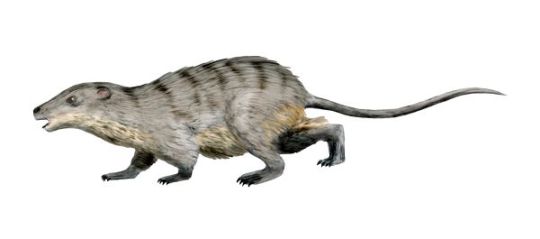
Eomaia by Nobu Tamura, CC BY-SA 3.0
There were the weird early derived Saurians (the group consisting of Lepidosauromorphs and Archosauromorphs, so Extant Reptiles), Choristoderans - Hyphalosaurus, which is known from thousands of specimens, and Monjurosuchus. Lizards included Dalinghosaurus, similar to the modern Chinese Crocodile Lizard; Liushusaurus and Yabeinosaurus, lizards relatedx to modern geckos and skinks, and Xianglong, a gliding lizard. Turtles included Manchurochelys and Ordosemys, both Cryptodirans, a group including giant tortoises, sea turtles, tortoises, snapping turtles, and others.

Hyphalosaurus by Matt Martyniuk, CC BY 3.0

Xianglong by Nobu Tamura, CC BY 3.0
The heroes of the formation were, of course, the Avemetatarsalians. There were many pterosaurs - Beipiaopterus, Boreopterus, Cathayopterus, Elanodactylus, Eosipterus, Feilongus, Gegepterus, Gladocephaloideus, Haopterus, Moganopterus, Ningchengopterus, Pterofiltrus, and Zhenyuanopterus.

Ningchengopterus by Nobu Tamura, CC BY 3.0
Ornithischians included the ornithopods Bolong, Jeholosaurus, and Jinzhousaurus, the ankylosaur Liaoningosaurus, and the ceratopsians Liaoceratops and Psittacosaurus. There were sauropods too - the titanosauriform Dongbeititan, a potential titanosaur, and an animal that has for now been referred to Euhelopus. But the real heavyweights were the theropods.

Jeholosaurus by @ryuukibart
There were the tyrannosauroids Yutyrannus - one of the best known tyrannosauroids with feathers - and Dilong; the compsognathus Huaxiagnathus, Sinocalliopteryx, and Sinosauropteryx - the first non-avian dinosaur known to have feathers, and also with known coloration; early Ornithomimosaurs such as Hexing and Shenzhousaurus; the early derived maniraptoran Yixianosaurus; Beipiaosaurus, a therizinosaur; and tons of Chickenparrots, such as Similicaudipteryx, Protarchaeopteryx, Ningyuansaurus, Incisivosaurus, and Caudipteryx.
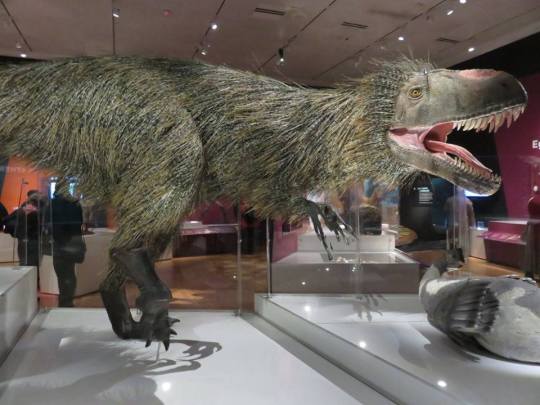
Yutyrannus, model from “Dinosaurs Among Us”, photo by me
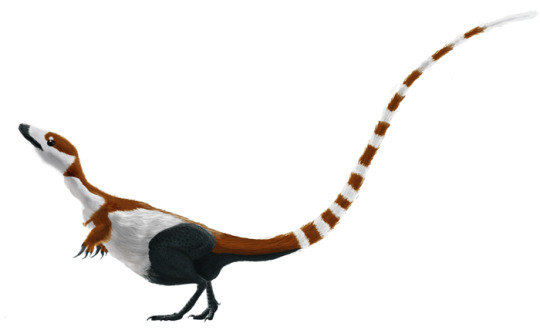
Sinosauropteryx by Matt Martyniuk, CC BY-SA 3.0
There were many Dromaeosaurids (raptors), such as Graciliraptor, Tianyuraptor, Zhenyuanlong - a raptor known from nearly complete feather traces, including extremely large wings - and Sinornithosaurus, the first Dromaeosaurid found with feathers. There were also lots of Troodontids, such as Sinusonasus, Sinovenator, and Mei, as well as unnamed members of both groups. There were early-derived Avialans such as Zhongornis, Jixiangornis, Confuciusornis, and Changchengornis. There were loads of Enantiornithines, such as Bohaiornis, Eoenantironis, Dalingheornis, Liaoningornis, Longirostravis, and Shanweiniao - an Enantiornithine that had a tail fan like modern birds. There were also Euornithines - the group which contains modern birds - such as Longicrusavis, Hongshanornis, and Archaeorhynchus. In short, this was an extremely birdy formation indeed.

Zhenyuanlong by Emily Willoughby, CC BY-SA 4.0
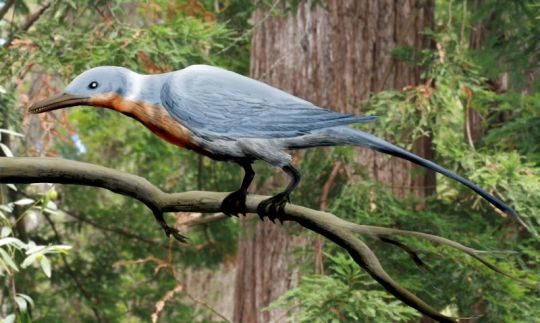
Shanweiniao by Nobu Tamura, CC BY 3.0
The Jiuofotang Formation was slightly younger, but was similar to the Yixian in terms of the animals there. There were ray finned fishes such as Jinanichthys, Lycoptera, Peipiaosteus, Protsephurus, and Sinamia. There was the mammal Liaoconodon, a Eutriconodont, as well as an unnamed mammal similar to Eomaia from the Yixian Formation. There were also Choristoderans like Philydrosaurus, Ikechosaurus, and Liaoxisaurus.

Liaoconodon by Dylan Bajda, CC BY-SA 4.0
There were many, many, many pterosaurs. This included Chaoyangopterus, Eoazhdarcho, Guidraco, Ikrandraco, Jidapterus, Liaoningopterus, Liaoxipterus, Linlongopterus, Nemicolopterus, Nurhachius, Shenzhoupterus, and Sinopterus. And, as we shall see, there were a lot of flying theropods as well, indicating that the two groups did live alongside one another just fine, and the common narrative of “birds replaced pterosaurs” has little foundation in the fossil record.
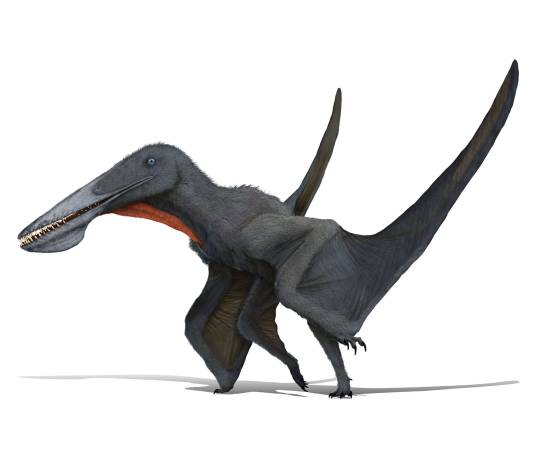
Ikrandraco, by Fabrizio De Rossi, from www.pteros.com

Chaoyangopterus, by Joschua Knüppe, from www.pteros.com
There were only a few Ornithischians - namely Chuanqilong, an ankylosaur, and Psittacosaurus, a ceratopsian. There is also an unnamed titanosaur from the formation. As for theropods, there were a lot. The tyrannosauroid Sinotyrannus was the largest predator there, there was the Chickenparrot Similicaudipteryx, and of course one of the most famous raptors, Microraptor, which was a four-winged Dromaeosaurid that we know had iridescent black feathers.
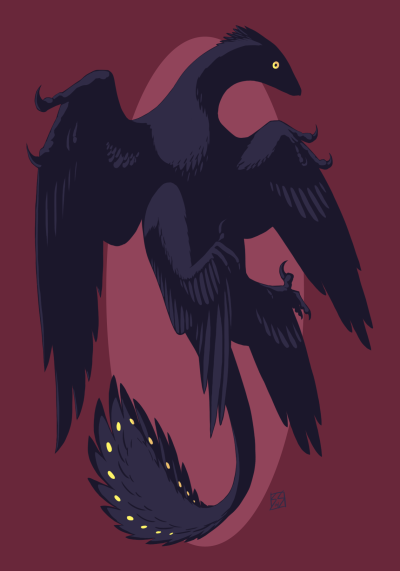
Microraptor by @artisticthingem
There were many early derived Avialans, such as Confuciusornis, Dalianraptor, Omnivoropteryx, Sapeornis, Shenshiornis, Zhongjianornis, and my personal favorite, Jeholornis, a theropod we know was a seed-eater, which is actually quite hard to determine from fossils. There were many Enantiornithines, such as Alethoalaornis, Boluochia, Cathayornis, Cuspirostrisornis, Dapingfangornis, Eocathayornis, Gracilornis, Huoshanornis, Largirostrornis, Longchengornis, Longipteryx, Rapaxavis, Xiangornis, and one of my favorites, Sinornis, which is thought to have perched. As for Euornithines, there was Chaoyangia, Jianchangornis, Parahongshanornis, Schizooura, Songlingornis, Yanornis, and Yixianornis.

Jeholornis by Matt Martyniuk, CC BY-SA 3.0
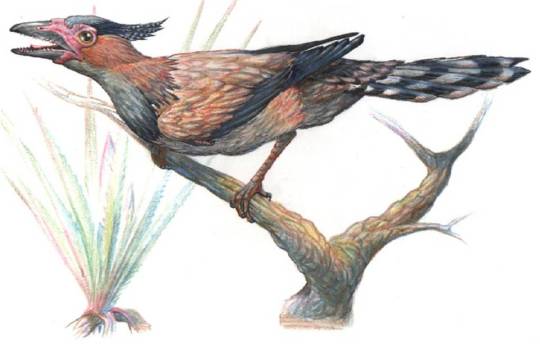
Sinornis, by Pavel Rhia, CC BY-SA 3.0
It’s plain to see why the Jehol Biota is so fascinating. At least for me, I love it because it’s clearly one of the best pictures we have of Pennaraptoran evolution - the amount of birdie dinosaurs is absolutely ridiculous. But there’s really something for everyone here - there are titanosaur-like things, some of the earliest Ceratopsians, tons of Pterosaurs, weird Choristoderans, and even some insights into the evolution of early mammals and different types of amphibians and fish, as well as the first flowering plants. The Jehol Biota is one of the best ecosystems we know about, and it definitely deserves celebration!
Sources:
https://en.wikipedia.org/wiki/Jehol_Biota
https://en.wikipedia.org/wiki/Jiufotang_Formation
https://en.wikipedia.org/wiki/Yixian_Formation
#dinosaurs#birds#pterosaurs#jehol biota#palaeoblr#prehistoric life#yixian formation#jiufotang formation
123 notes
·
View notes